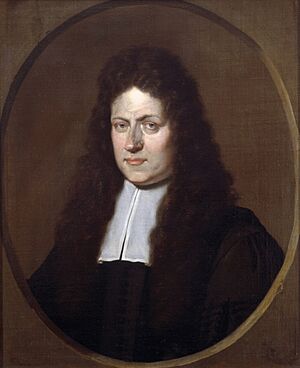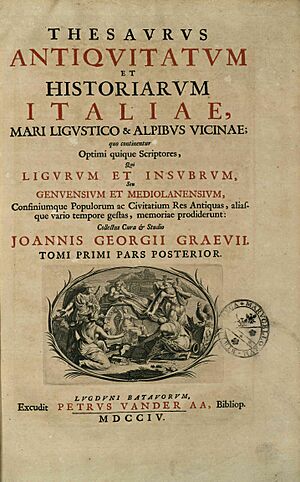Johann Georg Graevius facts for kids
Johann Georg Graevius (born Grava or Greffe) was an important German classical scholar and critic. He was born in Naumburg, Germany, in 1632. He became very well-known for his deep knowledge of ancient Greek and Roman writings.
His Life Story
Johann Georg Graevius was first expected to study law. However, during a visit to Deventer, he met a famous scholar named Johann Friedrich Gronovius. This meeting changed Graevius's path completely. He decided to leave law and study philology instead. Philology is the study of language in historical sources.
He continued his studies with other great teachers. These included Daniel Heinsius in Leiden and David Blondel in Amsterdam. While in Amsterdam, he changed his religious views. In 1656, he was invited to teach rhetoric at the University of Duisburg. Rhetoric is the art of speaking or writing effectively.
Just two years later, he moved to Deventer to take over from his mentor, Gronovius. In 1662, he joined the University of Utrecht. There, he first taught rhetoric. From 1667 until his death, he also taught history and politics.
A Popular Teacher
Graevius was a very popular teacher. His classes were always full of students. Many important people from all over the world came to learn from him. Even King Louis XIV of France honored him. William III of England, who was King of England, Scotland, and Ireland, especially liked Graevius. King William III even made him the royal historian.
Graevius had a huge library. It was filled with many old and rare classical books. After he passed away, his library was bought by Johann Wilhelm, Elector Palatine. Some of these books later went to Heidelberg University Library.
Graevius died in Utrecht in 1703.
His Important Works
Graevius created two very important collections of ancient writings. One was called Thesaurus antiquitatum Romanarum. This huge work was published between 1694 and 1699 in 12 volumes. It was a collection of information about ancient Rome.
The other major work was the Thesaurus antiquitatum et historiarum Italiae. This book was published after his death, starting in 1704. It was continued by another scholar, Pieter Burmann the Elder. This collection focused on the history and ancient items of Italy.
He also prepared new versions of many classic books. These included works by famous ancient writers like Hesiod, Lucian, and Suetonius. He also worked on several books by Cicero, a famous Roman speaker and writer. His editions helped improve the study of these ancient texts.
Graevius also helped publish the writings of other scholars from his time. He wrote letters to many scholars across Europe. One of these was Albert Rubens, the son of the famous painter Peter Paul Rubens. Albert Rubens was also a scholar who studied ancient coins and clothing. After Albert Rubens died, Graevius helped edit and publish his essays. These essays were about ancient clothing, coins, and gems.



